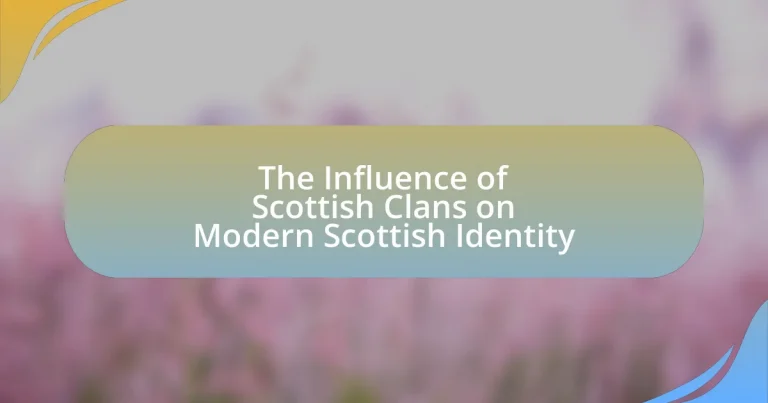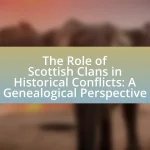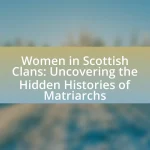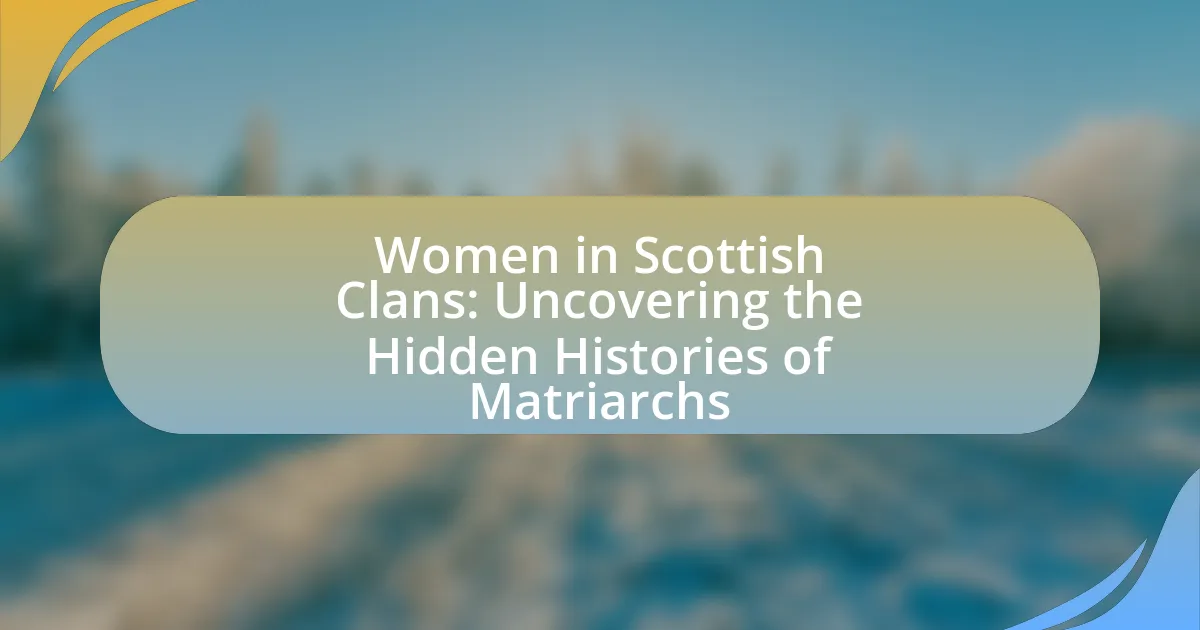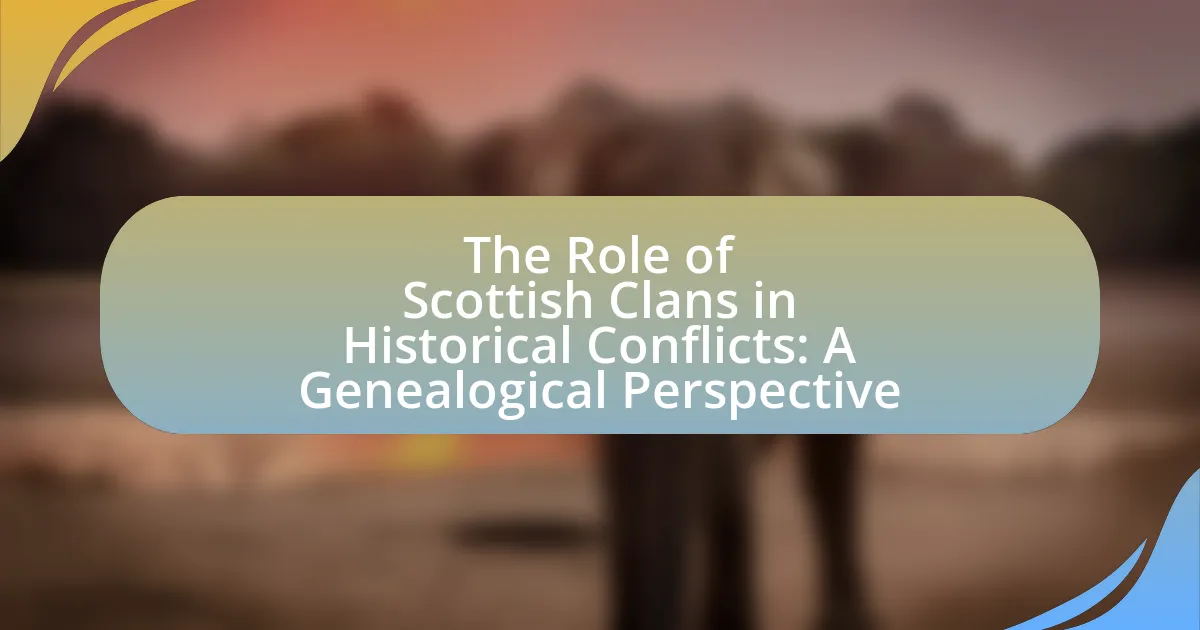Scottish clans play a crucial role in shaping modern Scottish identity by fostering community, heritage, and cultural pride. They serve as symbols of historical lineage and regional identity, with many Scots identifying with specific clans through gatherings, festivals, and tartan patterns. The article explores how clans influenced Scotland’s historical identity, social structures, and cultural expressions, while also addressing the challenges they face in preserving their identity in contemporary society. Additionally, it highlights the significance of clan heritage in promoting national pride and the ongoing connection between clans and the global Scottish diaspora.
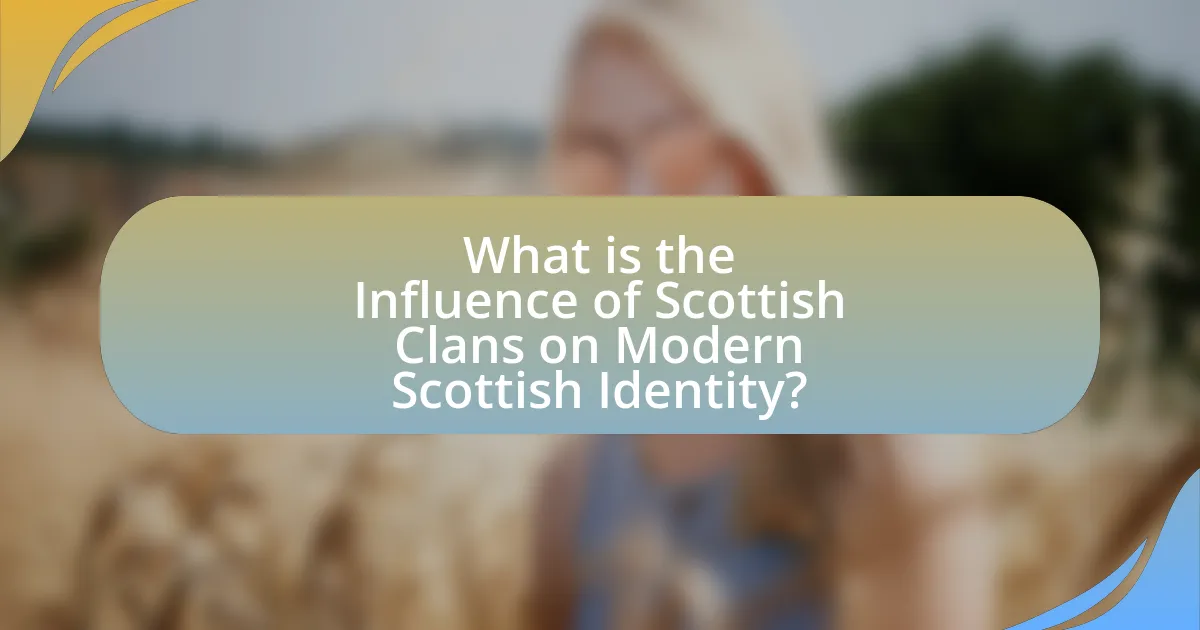
What is the Influence of Scottish Clans on Modern Scottish Identity?
Scottish clans significantly influence modern Scottish identity by fostering a sense of community, heritage, and cultural pride. Clans serve as symbols of historical lineage and regional identity, with many Scots identifying with specific clans that represent their ancestry. This connection is reinforced through clan gatherings, festivals, and the use of tartan patterns, which are emblematic of clan affiliation. Additionally, the resurgence of interest in clan history and genealogy has led to a revitalization of traditional Scottish customs and practices, further embedding these elements into contemporary Scottish identity. The Scottish Government recognizes this cultural significance, promoting clan heritage as part of Scotland’s national identity, which underscores the enduring impact of clans on the collective consciousness of modern Scotland.
How did Scottish clans shape the historical identity of Scotland?
Scottish clans significantly shaped the historical identity of Scotland by establishing social structures, cultural practices, and political allegiances that defined regional identities. Clans served as the primary units of social organization in Scotland, fostering loyalty and kinship among members, which was crucial during periods of conflict, such as the Wars of Scottish Independence in the 13th and 14th centuries. The clan system also contributed to the preservation of Gaelic culture, language, and traditions, as clans often acted as custodians of local customs and folklore. Furthermore, the clan system influenced land ownership and governance, with clan chiefs wielding considerable power and authority, which played a vital role in shaping Scotland’s feudal landscape. The legacy of these clans continues to resonate in modern Scottish identity, as evidenced by the enduring popularity of clan tartans and the celebration of clan heritage in contemporary Scottish culture.
What roles did clans play in the social structure of Scotland?
Clans were fundamental to the social structure of Scotland, serving as primary units of kinship, loyalty, and identity. Each clan functioned as a social network that provided support, protection, and resources to its members, fostering a sense of belonging and community. Historically, clans were often led by a chief, who held authority and responsibility for the welfare of the clan, reinforcing social hierarchies and governance within Scottish society. The clan system also played a crucial role in land ownership and agricultural practices, as clans controlled territories and managed resources collectively, which was essential for survival in the often harsh Scottish landscape. Additionally, the clan system contributed to the development of distinct cultural identities, as each clan maintained unique traditions, languages, and customs, which have persisted into modern times, influencing contemporary Scottish identity.
How did clan rivalries influence Scottish culture and identity?
Clan rivalries significantly shaped Scottish culture and identity by fostering a strong sense of loyalty and community among clan members. These rivalries often manifested in conflicts that reinforced distinct cultural practices, traditions, and social structures unique to each clan. For instance, the historical feuds between clans such as the MacDonalds and the Campbells not only influenced territorial disputes but also led to the development of specific clan symbols, tartans, and folklore that are integral to Scottish heritage. Additionally, these rivalries contributed to a collective identity among Scots, as they often rallied around their clans during conflicts, which solidified their cultural narratives and historical memory. The legacy of these rivalries continues to be celebrated in modern Scottish festivals and events, highlighting their enduring impact on Scottish identity.
What are the key characteristics of Scottish clans that impact modern identity?
Scottish clans are characterized by their strong sense of kinship, unique tartan patterns, and historical significance, all of which significantly impact modern identity. The kinship ties foster a sense of belonging and community among individuals, often leading to clan gatherings and events that reinforce cultural heritage. Unique tartan patterns serve as visual symbols of clan identity, allowing individuals to express their heritage and pride. Historically, clans played crucial roles in Scottish society, influencing social structures and local governance, which continues to resonate in contemporary discussions about Scottish nationalism and identity. These characteristics collectively shape how individuals connect with their Scottish heritage today, promoting a shared identity rooted in tradition and history.
What traditions and customs are associated with Scottish clans?
Scottish clans are associated with several traditions and customs, including the wearing of tartan, clan gatherings, and the practice of clan crests. Tartan patterns represent specific clans and are worn during formal events, symbolizing clan identity and heritage. Clan gatherings, such as the Highland Games, serve as social events where members celebrate their lineage through competitions and cultural displays. Additionally, clan crests, often depicted on shields or banners, signify the unique identity of each clan and are used in heraldry. These customs reinforce a sense of belonging and continuity among clan members, reflecting the historical significance of clans in Scottish culture.
How do clan symbols and tartans contribute to Scottish identity today?
Clan symbols and tartans significantly contribute to Scottish identity today by serving as visual representations of heritage and community. These symbols, often associated with specific clans, evoke a sense of belonging and pride among Scots, both in Scotland and the diaspora. For instance, the use of tartans in various cultural events, such as Highland games and weddings, reinforces traditional ties and collective identity. Historical records indicate that tartans were used as early as the 16th century, and their revival in the 19th century during the Victorian era further solidified their role in Scottish nationalism. Today, the Scottish Register of Tartans maintains over 7,000 registered tartans, showcasing their importance in contemporary Scottish culture and identity.
Why is the legacy of Scottish clans significant in contemporary Scotland?
The legacy of Scottish clans is significant in contemporary Scotland because it shapes national identity and cultural heritage. Clans represent historical ties, social structures, and regional identities that continue to influence Scottish society today. For instance, clan gatherings and events, such as the Clan Gathering in Edinburgh, celebrate this heritage, fostering community and pride among Scots and those of Scottish descent worldwide. Additionally, the use of clan symbols, tartans, and names reinforces a sense of belonging and continuity, linking modern Scots to their ancestral roots. This ongoing connection to clan history is evident in cultural expressions, such as music, dance, and storytelling, which are integral to Scotland’s national identity.
How do clans influence modern Scottish nationalism?
Clans significantly influence modern Scottish nationalism by fostering a sense of identity and community among Scots. The historical legacy of clans, which includes their unique tartans, symbols, and traditions, contributes to a collective cultural heritage that many Scots embrace today. This connection to clan history reinforces national pride and unity, particularly during events like the Highland Games and clan gatherings, which celebrate Scottish culture and heritage. Furthermore, the resurgence of interest in clan identities in the 21st century has been linked to a broader movement for Scottish independence, as individuals seek to reclaim and celebrate their distinct cultural roots in the context of national identity.
What role do clans play in community and cultural events in Scotland?
Clans play a significant role in community and cultural events in Scotland by serving as a focal point for social cohesion and cultural identity. These clans organize and participate in various events such as Highland games, clan gatherings, and festivals, which celebrate Scottish heritage and traditions. For instance, the annual Braemar Gathering attracts thousands of participants and spectators, showcasing traditional sports and music, reinforcing clan pride and unity. Additionally, clans often engage in charitable activities and community service, further embedding themselves within local cultures and enhancing their relevance in contemporary Scottish society.
How do Scottish clans connect with the diaspora and global identity?
Scottish clans connect with the diaspora and global identity through cultural heritage, community networks, and events that celebrate Scottish traditions. Clans serve as a focal point for individuals of Scottish descent worldwide, fostering a sense of belonging and shared identity. For instance, the annual Highland Games and clan gatherings attract thousands of participants and spectators, reinforcing connections among Scots and their descendants globally. Additionally, organizations like the Scottish Clan Association promote clan history and heritage, facilitating connections through resources and events that engage the diaspora. This engagement is evident in the estimated 50 million people of Scottish descent living outside Scotland, who often identify with their clan’s history and values, thereby maintaining a global Scottish identity.
What challenges do modern Scottish clans face in preserving their identity?
Modern Scottish clans face significant challenges in preserving their identity, primarily due to globalization, urbanization, and the dilution of traditional practices. Globalization has led to the homogenization of cultures, making it difficult for clans to maintain distinct customs and languages. Urbanization further complicates this issue, as clan members increasingly move to cities, resulting in a disconnection from their rural roots and traditional clan gatherings. Additionally, the younger generation’s shifting interests and priorities often lead to a decline in participation in clan activities, threatening the transmission of cultural heritage. These factors collectively hinder the ability of modern Scottish clans to sustain their unique identities in a rapidly changing world.
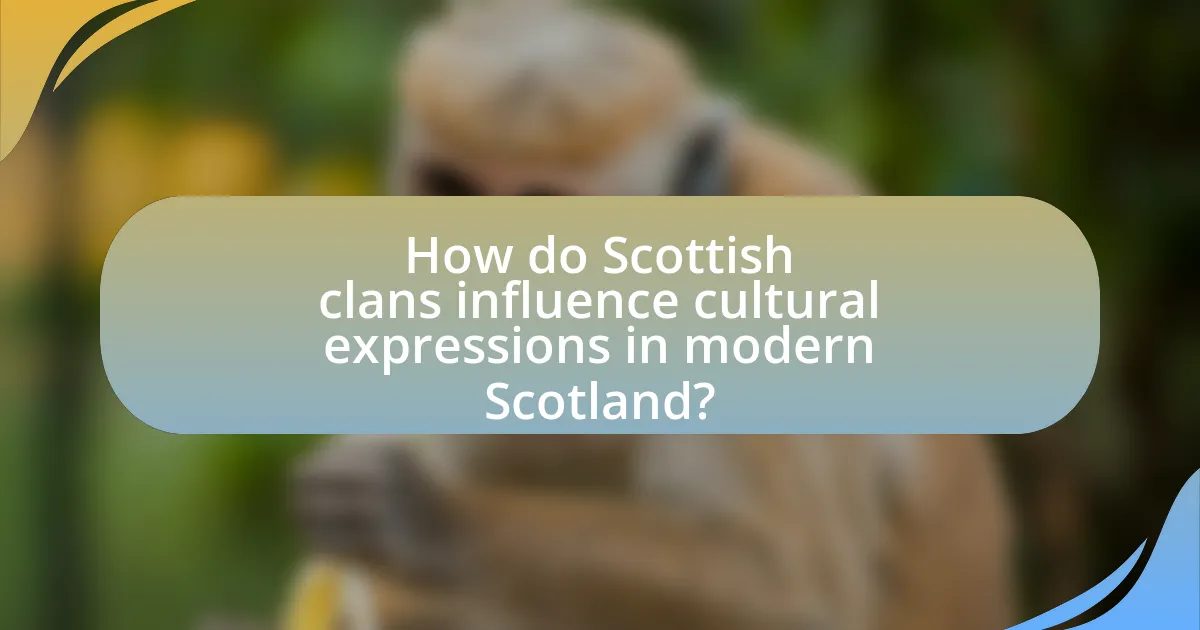
How do Scottish clans influence cultural expressions in modern Scotland?
Scottish clans significantly influence cultural expressions in modern Scotland through their historical traditions, symbols, and community events. Clans maintain a strong presence in Scottish identity, with clan tartans, crests, and gatherings serving as vital cultural markers. For instance, the annual Clan Gathering at Edinburgh Castle showcases traditional music, dance, and storytelling, reinforcing clan heritage and fostering community ties. Additionally, the resurgence of interest in genealogy has led many Scots to explore their clan affiliations, further embedding these identities into contemporary cultural practices. This connection to clan history is evident in festivals, where traditional attire and customs are celebrated, illustrating the ongoing relevance of clans in shaping modern Scottish cultural expressions.
What forms of art and literature reflect the influence of clans?
Art and literature that reflect the influence of clans include traditional Scottish poetry, storytelling, and visual arts such as clan heraldry and tartan designs. Traditional Scottish poetry often celebrates clan history and values, with poets like Robert Burns incorporating themes of loyalty and heritage. Storytelling, particularly in the form of oral traditions, preserves clan legends and histories, reinforcing clan identity. Visual arts, including clan crests and tartans, serve as symbols of clan affiliation and pride, with specific patterns representing different clans. These forms of expression collectively contribute to the understanding and preservation of clan culture within modern Scottish identity.
How do contemporary Scottish writers incorporate clan themes in their work?
Contemporary Scottish writers incorporate clan themes in their work by exploring the complexities of identity, heritage, and belonging associated with clan culture. For instance, authors like Ali Smith and James Robertson delve into the historical narratives and personal connections tied to clans, reflecting on how these elements shape modern Scottish identity. Their works often highlight the tension between tradition and contemporary life, illustrating how clan affiliations influence characters’ motivations and relationships. This thematic focus is supported by the resurgence of interest in Scottish history and culture, as seen in the popularity of literature that examines clan dynamics and their impact on personal and national identity.
What impact do clans have on traditional Scottish music and dance?
Clans significantly influence traditional Scottish music and dance by preserving cultural heritage and fostering community identity. Each clan often has its own unique musical styles, instruments, and dances that reflect their history and traditions, such as the use of bagpipes and specific folk dances like the ceilidh. Historical records indicate that clan gatherings and celebrations have been central to the transmission of these musical and dance forms, ensuring their continuity across generations. For example, the Clan MacGregor is known for its distinct musical repertoire, which has been passed down through family lines, reinforcing both clan loyalty and cultural pride.
How do clans contribute to tourism and economic identity in Scotland?
Clans significantly contribute to tourism and economic identity in Scotland by attracting visitors interested in heritage and cultural experiences. The presence of clan-related events, such as Highland games and clan gatherings, draws tourists who seek to connect with their ancestry and explore Scottish traditions. For instance, the Clan Gathering in Edinburgh attracts thousands annually, showcasing Scottish culture and generating substantial revenue for local businesses. Additionally, clan heritage sites, such as castles and battlefields, serve as focal points for tourism, enhancing Scotland’s economic landscape. According to VisitScotland, heritage tourism, which includes clan-related activities, contributes over £1 billion to the Scottish economy each year, highlighting the vital role clans play in shaping both tourism and economic identity in Scotland.
What role do clan gatherings and festivals play in attracting visitors?
Clan gatherings and festivals play a significant role in attracting visitors by showcasing cultural heritage and fostering community engagement. These events, such as the Highland Games and clan reunions, draw tourists interested in experiencing traditional Scottish customs, music, and sports. For instance, the Royal Edinburgh Military Tattoo attracts over 200,000 visitors annually, highlighting Scotland’s rich history and clan traditions. Such gatherings not only promote tourism but also strengthen the identity of Scottish clans, making them vital for cultural preservation and economic benefit.
How do clan-related businesses support local economies?
Clan-related businesses support local economies by creating jobs, fostering community engagement, and promoting local culture. These businesses often prioritize hiring local residents, which reduces unemployment and stimulates economic growth within the community. For example, clan-owned enterprises such as hotels, restaurants, and craft shops attract tourists interested in Scottish heritage, thereby increasing local spending. According to a report by the Scottish Government, tourism related to cultural heritage contributes approximately £4.5 billion annually to Scotland’s economy, highlighting the significant impact of clan-related businesses on local financial health. Additionally, these businesses often engage in community events and sponsorships, further strengthening local ties and enhancing the overall economic ecosystem.

What is the future of Scottish clans in shaping identity?
The future of Scottish clans in shaping identity is likely to be characterized by a resurgence in cultural pride and community engagement. As global interest in heritage and ancestry grows, clans are increasingly seen as vital components of Scottish identity, fostering connections among individuals with shared lineage. This trend is supported by the rise of genealogy research and clan gatherings, which have become more popular in recent years, indicating a strong desire among Scots and those of Scottish descent to reconnect with their roots. Furthermore, the Scottish Government’s support for cultural initiatives and events, such as the Homecoming Scotland festival, reinforces the importance of clans in promoting national identity and heritage.
How are modern Scottish clans adapting to contemporary society?
Modern Scottish clans are adapting to contemporary society by embracing technology, promoting cultural heritage, and engaging in community initiatives. Clans are increasingly using social media platforms to connect with members globally, share their history, and organize events, which enhances their visibility and relevance. For instance, many clans host virtual gatherings and online educational programs that attract younger generations, ensuring the transmission of traditions. Additionally, clans are actively participating in charitable activities and local community projects, which helps to strengthen their social impact and foster a sense of belonging among members. This adaptation reflects a broader trend of cultural preservation while remaining relevant in a modern context.
What initiatives are in place to promote clan heritage among younger generations?
Initiatives to promote clan heritage among younger generations include educational programs, cultural festivals, and digital resources. Educational programs in schools often incorporate lessons on Scottish history and clan traditions, fostering a sense of identity. Cultural festivals, such as Highland Games and clan gatherings, provide opportunities for young people to engage with their heritage through music, dance, and storytelling. Additionally, digital resources, including websites and social media platforms dedicated to clans, offer accessible information and community engagement, allowing younger generations to connect with their clan’s history and values. These initiatives collectively aim to instill pride and knowledge of clan heritage in youth, ensuring its continuation.
How do clans engage with technology and social media to enhance their presence?
Clans engage with technology and social media by creating online platforms that promote their heritage and foster community interaction. These platforms, such as dedicated websites and social media accounts, allow clans to share historical information, organize events, and connect with members globally. For instance, many clans utilize Facebook groups and Instagram to showcase clan gatherings, share stories, and celebrate cultural traditions, thereby enhancing their visibility and relevance in contemporary society. This digital engagement not only preserves clan identity but also attracts younger generations, ensuring the continuation of their cultural legacy.
What practical steps can individuals take to connect with their clan heritage?
Individuals can connect with their clan heritage by researching their family history through genealogical resources and clan websites. Engaging with local clan societies or attending clan gatherings fosters a sense of community and belonging. Participating in cultural events, such as Highland games or Scottish festivals, allows individuals to experience traditional customs and practices associated with their clan. Additionally, learning the clan’s history, symbols, and tartans can deepen one’s understanding and appreciation of their heritage. These steps are supported by the existence of numerous genealogical databases and active clan organizations that promote heritage awareness and education.
